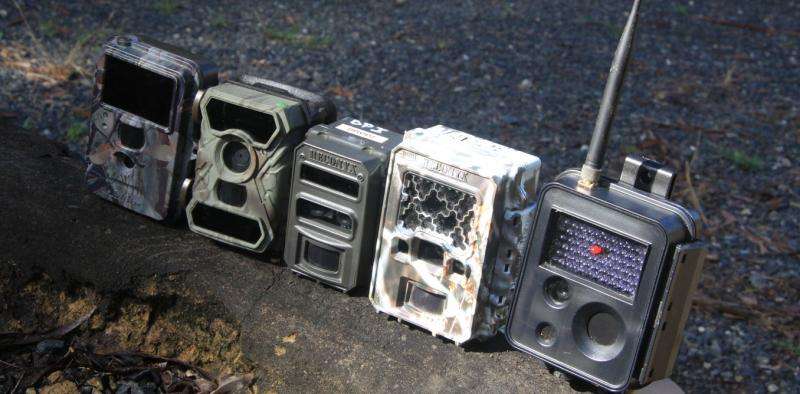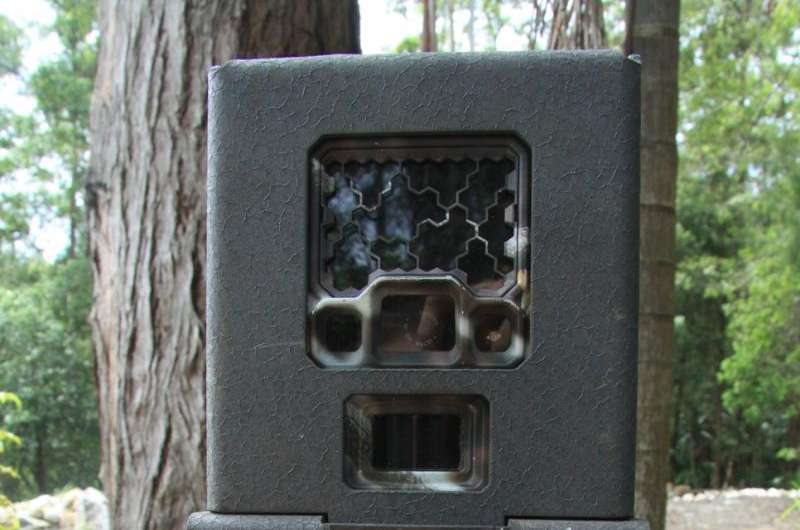How to stop the thieves when all we want to capture is wildlife in action

Many Australian field scientists, including myself, have been swayed in recent years by the attraction of using camera traps to survey wildlife.
But we've also attracted some unsavoury characters of the human form who are seriously threatening the viability of our research.
Camera trap devices (typically costing A$300 to A$900 each) don't require a human operator to push the button; they can be remotely deployed in the bush taking photos for months with the sole function of recording animals.
They were used by the BBC to capture rare footage of the snow leopard for David Attenborough's Earth II series.
Camera traps have led to some fantastic ecological findings, including newly discovered species such as the Olinguito from South America; extensions of the species range of rare predators such as Pallas' cat in Iran; and previously unrecorded animal behaviours such as dingo cannibalism.
Importantly, they have reduced the cost of conducting surveys for wildlife that are normally expensive and resource-intensive.
Camera traps are now the "go-to" survey tool for scientists and a device used by farmers, land managers and citizen scientists alike. They are showing us pictures of animals doing things they only do when humans are not present.
But these unaccompanied pieces of technology are vulnerable to antisocial behaviours that are normally associated with humans in urban environments.
Camera thefts and vandalism
The theft and vandalism of remote scientific equipment is not new, but the exponential adoption of camera traps across the world has significantly increased the chance of an encounter between human and device.
The level of risk and financial loss has reached breaking point and is causing us scientists to revisit how we use camera traps to prevent theft.
In the cohort of dedicated wildlife researchers I work with, we have lost more than A$70,000 worth of equipment in recent years due to theft.
Camera traps are usually fixed to posts or trees at sites where animals are most likely to pass and therefore be detected.
In our research, we primarily study predators – such as dingoes, foxes and feral cats – so our camera traps are set in transects along roads and trails in the bush. This makes them very obvious to would-be thieves.
Following the theft of 15 camera traps in 2011 from one of our research trials in New South Wales, we grappled with how we might avoid having our equipment, and the precious data contained within, from being stolen.
An elevated approach
We initially thought we could put them 3 metres high in trees, hoping thieves would not see them because they were out of their line of sight.
Initial trials confirmed that most people had no idea that our camera traps were in the trees, so it looked promising.
That was until we conducted a further trial to compare the wildlife detected at different camera trap heights and realised that the higher the devices, the less we detected. So that option was off the drawing board.
Following this, we designed a security post that encased the camera trap in a steel box welded to a steel post with a lock shield (to prevent them from being ground off), and sunk 1m into the ground with two bags of concrete.
We attached friendly notes to the posts letting people know that we were only interested in animals and that pictures of people would be deleted.
Initial field trials looked promising. Some people kicked them or bumped into them with their vehicles but no one removed the posts. So we set up several 25km transects of camera trap security posts in the forest in the Northern NSW Tablelands and Coffs Coast.
A determined attack
But within a few days of deployment, one post at Coffs Harbour was pulled out of the ground by a large machine, leaving a large chasm in the ground.
Within a week, 11 more had been put through every conceivable extraction method – all failed. So the thieves took to our posts with battery-powered grinders and we were 12 camera traps short.
Not to be outsmarted, we replaced the posts with Mad Max-like anti-missile constructed security posts. We even filled the concrete slurry poles with cheap nylon rope, hoping the plastic might melt and jam the grinding discs.

While this seemed to have worked, they recently found another weak spot: they found some of the old-style posts that had never been damaged, ground off sections of metal, put pneumatic jacks in the gaps and levered them apart like a can opener before extracting our code-locked camera traps along with our irreplaceable data.
In desperation, we have had to resort to placing camera traps in suboptimal sites to avoid areas we believe to be high-risk. Begrudgingly, guarding against theft has become an important factor in our experimental design.
Why steal the cameras?
We are often asked, why do people steal our camera traps? It's likely that at some sites we have intercepted some illegal activity and the criminals don't want to be identified.
In one case we know we recorded some illegal dumping, so the perpetrator removed the evidence by pulling up the whole post.
But overall it's confusing as to why people will go to such lengths to steal devices that we clearly advertise as code-locked and therefore unusable. What is it that drives people to theft and vandalism?
Most of the time I think these people just don't think about their actions and steal because they can. But there is no intellectual evaluation of the activity.
Sadly for practitioners, these mindless acts of transgression have dire consequences. Not only do we lose valuable and difficult to obtain financial resources, but we lose irreplaceable data on memory cards.
We need a solution
We have considered numerous solutions to these attacks, such as putting out nicely worded signs explaining our study, advising the community about our work in the media so they don't feel threatened, placing camera traps on camera traps to try and catch the thieves, even gluing leaves and bark on the camera traps as a form of camouflage.
We are testing tiny tracking systems but the technology is not suitable yet. We have tried it all and been thwarted.
We have now resorted to surveying our colleagues in the hope of gathering further evidence of the significance of this threat to science.
More than 300 camera trap practitioners have shared their economic and data loses and ideas with our team so far.
It is our hope that we may generate enough information on the effects of this degenerate behaviour, that we may find some technological solutions that will ultimately allow us to continue contributing to global science, without fear of losing our equipment and data.
Provided by The Conversation
This article was originally published on The Conversation. Read the original article.![]()


















